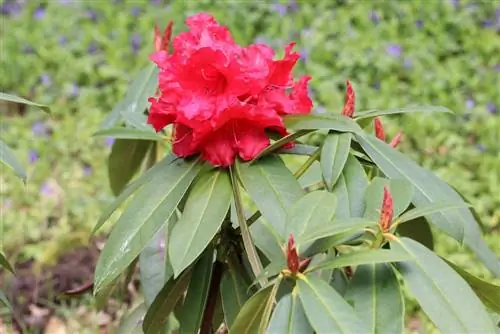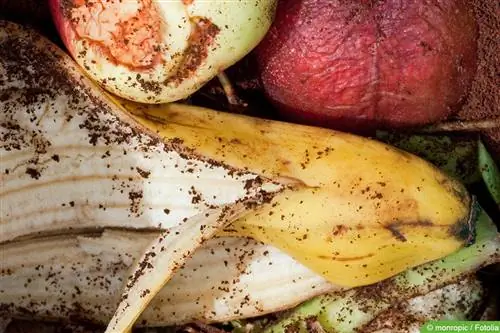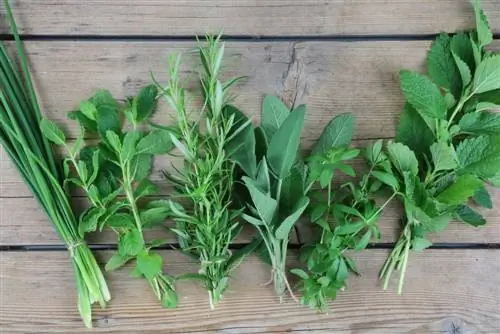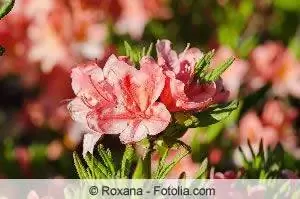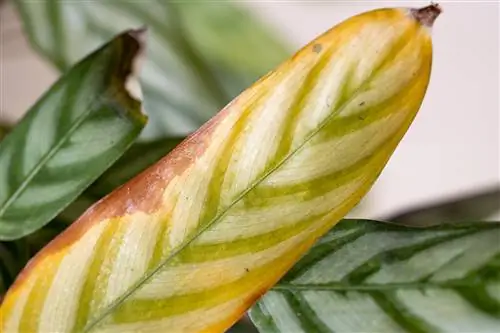- Author admin [email protected].
- Public 2023-12-17 03:39.
- Last modified 2025-01-24 12:45.
If the rhododendron does not receive the right care and is in the wrong location, it will quickly look dried out. In adverse conditions, the flowering bush separates itself from all above-ground parts of the plant that are not necessary for its survival. If the plant has been cared for incorrectly, appropriate countermeasures must be taken promptly to prevent it from dying completely.
Rododendron or Rhododendron
Spelling mistakes are often made when it comes to the plant; instead of rhododendron, many people write rododendron. The name is made up of the Greek “rhodon” for rose and “dendron” for tree, which is why this rose tree is always written with “h”.
Causes
If rhododendrons appear dried out, this can have many different causes. Most of the time the culprit is inadequate supply of water. Especially in the hot summer months with little rainfall, dried leaves, flowers and shoots quickly occur. During this time of year, many people also go on vacation, so the plants are not watered at all during this period. When it comes to irrigation, both the frequency and the amount of water used are crucial. These aspects must be individually adapted to the size of the flowering bushes, the site conditions and the weather.
- Long and extremely dry heat periods weaken the plants
- Insufficient watering units lead to dry spots
- Watering too rarely and at the wrong time
- In the midday heat, irrigation water evaporates quickly
- Lack of irrigation in dry winter
- Damaged roots reduce water absorption
- Too many leaves were removed when pruning
- Sensitive plant suffers from diseases
Review
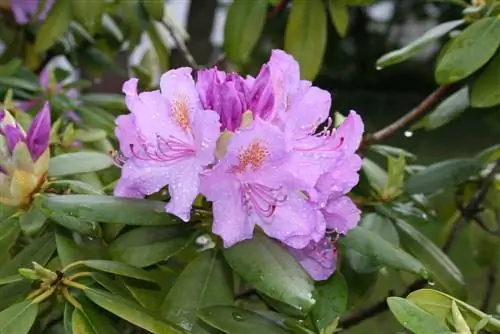
Whether the rhododendron is only dry on the outside or is already completely dead can be determined by carefully checking it. It is therefore important to pay attention to concrete facts in the plant that indicate that life is still present. If cell structures remain intact, the flowering bushes can form new plant tissue again. Only when the cells have lost more than seventy percent of water is the rhododendron in question as good as dead. Specimens that have dried out above ground can still live in the root area and can sprout again after the right measures. However, attempts to save a dried-out plant are often unsuccessful. Nevertheless, reviving is always worthwhile, especially when it comes to older and larger plants,
- Scrape off some bark to check
- Green in the trunk indicates life
- Trunk is still moist despite dried shoots
- Then rescue is possible
- Leaves are yellow, but not brown in color
- Shed leaves are often still green
- Flowers hang limply
- Leaves curl up together
Saving potted plants
As long as the roots of the potted plants are not damaged, attempts to save them are worthwhile and can certainly be successful. Since one of the most common causes of dry plant parts is a lack of watering units, the plants must first be supplied with plenty of liquid. However, with potted plants there is a risk of harmful overwatering. It is therefore advisable to give the plants an extensive water bath. Once the substrate has almost dried out, it will no longer be able to absorb and store water as well in the future. That's why repotting is a good idea, as this also ensures good ventilation. In addition, the weakened plant needs the right fertilizers to obtain vital nutrients. In this way, the rhododendron can regain its energy soon.
- Place the plant and its container in a bucket of water
- However, the container must have a drainage hole
- Otherwise put the plant in the water bath without a pot
- Roots and substrate must absorb sufficient water
- Only remove when no more air bubbles appear
- However, do not leave it in the water bath for longer than a day
- Repotting and providing fresh substrate
- Carry out intensive fertilizer treatment
- Fertilizers specifically for rhododendrons are ideal
- Never apply fertilizer to dry soil
Note:
Never place rhododendrons in direct sun. Provide sun protection in the midday heat on a window sill in full sun.
Rescuing bedding plants

Rescuing potted plants is much easier because they can be moved and repotted individually. However, this is not possible with rhododendrons in the bed. Small plants can still be carefully dug up and then placed in a water bath. Larger specimens, on the other hand, are firmly rooted in their location and cannot survive a move without serious damage. Nevertheless, a dry rhododendron in the bed can still be saved with the appropriate measures if the roots are still alive. It is important to protect against too much strong sun and evaporation in order to keep the moisture in the soil longer. In addition, the prevailing conditions at the location can also be changed to protect the plants from drought.
- First loosen the soil around the bushes
- Then water thoroughly, directly to the rhizome
- About 10-20 liters per day, depending on plant size and weather conditions
- Carry out casting sessions over several days
- Watering can with liter indication is ideal
- In full sun, apply sun protection
- Other plants that provide shade are ideal
- Lay a thick layer of mulch over the root area
- Only fertilize again when the plant has noticeably recovered
Tip:
In order to regularly supply the rhododendrons in the bed with enough water, an automatic irrigation system is recommended. In this way, even a longer vacation stay doesn't become a problem.
pruning
If the leaves of the flowering bushes are almost completely brown, new growth is extremely unlikely. Curled and dried leaves provide natural protection against excessive evaporation. In this case, the plants should be cut back promptly to avoid further drying out. In this way, the already very weakened plant does not waste itself on caring for the dried shoots. The rhododendron then puts its remaining energy into the development of new shoots. Pruning is necessary for both potted plants and bedding plants, and not just for visual reasons. This allows the plant to regenerate again and will soon sprout again if further care meets the respective requirements. Depending on how dry the rhododendron has already been, the new shoots can occur quickly or take longer.
- Cutting promotes new growth
- To revive, radically cut back
- Cut off all dried plant parts completely
- Make the cut close to the trunk
- If possible, leave main shoots standing
- If necessary, even cut back to the cane
- Make sure your scissors are sharp and disinfected
- Avoid unnecessary injuries at all costs

